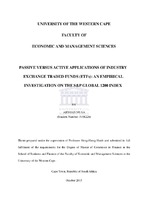| dc.description.abstract | The notion of market efficiency posits that stock prices fully reflect all available information in a timely manner. The efficient market hypothesis (EMH) proposed by Fama (1970) systematically rules out the profitability of information driven investing, and implicitly promulgates a passive market capitalisation weighted investment strategy such as indexing. The appeal of passive strategies has largely been driven by the growth of passive tracking instruments, which allow investors to earn underlying index performance by purchasing a single security such as an exchange traded fund (ETF). On the contrary, proponents of behavioural finance suggest that investors are irrational and subject to psychological biases.
Furthermore, the noisy market hypothesis of Siegel (2006) asserts that the deviations from the economic ideal of rationality proposed by the EMH, introduces noise in the market which could lead prices to deviate from their intrinsic values. The resultant drag in performance of market capitalisation weighted indices suggests that the optimal cap-weighted market portfolio promulgated by the modern portfolio theory (MPT) of Markowitz (1952), ceases to be the most mean-variance approach to asset allocation. With the goal of testing the
applications of ETF’s, this study first evaluates the performance of passive sector ETF’s in the global equity market. In addition, motivated by the potential inefficiencies of capweighted portfolios, the study tests optimisation based asset allocation techniques, and technical analysis based market timing strategies. The study employs the S&P Global 1200 sector indices and their respective sector ETF’s to test their performances and applications in passive and active investment strategies, over the period from July 5th, 2002 to February 6th, 2015. The ETF’s are evaluated based on their tracking ability and price efficiency. All 10 sector ETF’s possess insignificant tracking errors and successfully replicate the performance of their underlying indices. In addition, the globalsector ETF’s are not price efficient over the study period, as they possess persistent price deviations from their net asset values (NAV’s). Furthermore, the ETF trading strategy based
on the relationship between ETF returns and price deviations, proves to be effective in outperforming the passive buy and hold strategy in the majority of the sectors. The sector decomposition of the cap-weighted S&P Global 1200 index which is employed as the market proxy, reveals that its sector allocation remains fairly stable throughout the study period. In contrast, the optimal historical sector composition incurs large changes in sector exposure from year to year and provides substantially superior performance relative to the cap-weighted market portfolio. The cap-weighted portfolio tends to overweight cyclical sectors and underweight resilient sectors during major economic downturns. The long-only,
long-short and market neutral strategies developed from the S&P Global 1200 index and its constituent sector indices provide exceptional risk-adjusted performance, and more meanvariance efficient portfolios than the cap-weighted market proxy. The relaxation of the longonly constraint also improves the optimised portfolios risk-adjusted performance, mainly through risk reduction benefits. The performance of the optimised global sector based portfolios also resembles the performances of the global style based optimised portfolios
developed by Hsieh (2010), thereby suggesting that the two approaches are analogous. The 3 technical market timing strategies tested in this research provide varying results. The sector momentum portfolios experience significant positive returns during bull markets, however the portfolios incur significant drawdowns during periods of economic turmoil such as the 2008 global financial crisis. As a result, all sector momentum portfolios provide inferior risk-adjusted returns relative to the passive cap-weighted buy and hold strategy. The exponential moving average (EMA) trend timing strategy promulgated by Hsieh (2010)
provides impressive risk-management attributes and superior risk-adjusted performance relative to passive buy and hold benchmarks. Similarly, the alternative technical charting heuristics trend timing strategy helps reduce drawdowns during market crashes, however the charting strategy provides inferior cost and risk-adjusted performance relative to the capweighted buy and hold approach due to larger timing errors and longer hedging periods in comparison to the EMA strategy. In addition, the global tactical sector allocation (GTSA) model tests the EMA and technical charting trend timing tools in the context of a global
sector portfolio, and the model provides outstanding cost and risk-adjusted performances relative to the passive investing alternatives. The portfolio based GTSA model highlights the benefits of portfolio diversification and successfully hedges market exposure during economic downturns. | en_US |

